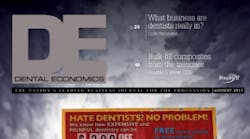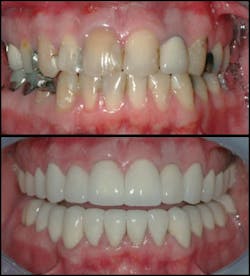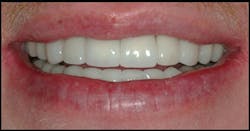A reader notes a trend in which many dentists are removing teeth that are restorable and placing dental implants and crowns or fixed prostheses in their place. He asks if dentists should still encourage patients to retain teeth that require significant restorative and/or periodontal treatment. Dr. Gordon Christensen gives his expert opinion.
Q:
I am frustrated with the current trend I see with dentists removing teeth that are restorable and placing dental implants and crowns or fixed prostheses in their place. Some of my previous patients who have moved away are being encouraged by their new dentists to have their teeth removed and replaced with implant-supported fixed prostheses at a major cost. Knowing my previous patients well, I am aware that some of them have functionally restored teeth, and yet they are being advised to have them removed. Some of these patients have come back and asked for my opinion on this concept. Am I incorrect? Should we still encourage patients to retain teeth that require significant restorative and/or periodontal treatment?
A:
As a prosthodontist, I have been placing and restoring implants for more than 30 years and have observed significant and impressive success. However, now that we have watched root-form implants for many years, we are far more knowledgeable about their advantages and limitations. I will briefly discuss my observations based on research and my personal experience, having had the opportunity to watch thousands of teeth and implants in service over several decades.
What conditions necessitate tooth removal?
Numerous conditions cause dentists to suggest tooth removal, and most dentists know these conditions well. However, with proper clinical skills, even most of the following types of problems can be treated successfully without tooth removal:
- Dental caries involving most or all of the coronal portion of the tooth
- Bruxism and the accompanying occlusal wear destroying most or all of the coronal portion of the tooth
- Ongoing periodontal disease with major tooth mobility
- Severe bone loss and subsequent major tooth mobility
- Vertically fractured teeth
- Portions of the tooth broken off apical to the bone
- Tooth resorption with inability to remove enough of the resorption to properly restore
- Accidents causing tooth fracture, intrusion, and bone fracture
- Lack of patient cooperation with oral hygiene
- Lack of patient cooperation with diet
- Inadequate financial ability to pay for treatment
- Combinations of two or more of the above conditions
Patient motivation to remove teeth
We dentists must accept some of the responsibility for patient desire for tooth removal. Patients can become extremely frustrated with the constant need for dental restorations and continued dental caries, periodontal breakdown, or occlusal wear. Are we counseling patients adequately about how to reduce or eliminate dental caries activity, how to slow down periodontal disease, and how to prevent significant occlusal wear? I am confident many of us could do better.
What about patient behavior relative to diet, oral hygiene, and many other factors negative to optimum oral health? Changing adult behavior is almost impossible without education and motivation. I had no dental education as a child, and I had many carious lesions requiring significant restorative treatment as I entered dental school. After knowing what causes dental caries and how to prevent the disease, I have had almost no caries for several decades. If both dentists and patients really worked together, almost all oral disease would be prevented!
What are the characteristics of natural teeth relative to implants?
There are several distinguishing attributes that differentiate natural teeth and dental implants:
- The periodontal ligament allows teeth to have a shock-absorbing characteristic. Teeth move in the bone throughout life, usually maintaining contact areas and constantly adjusting to occlusal and muscular forces.
- Implants do not exhibit appreciable movement. Commonly, implants placed adjacent to natural teeth develop open contacts over their period of service.
- Teeth have a natural attachment to gingival tissues, the epithelial attachment. If this is maintained well, gingival health can be optimum. Implants do not have this natural attachment.
- There is growing concern about the prevalence of peri-implantitis. Estimates range from 10% to over 40% after several years of service. A recent study of 588 patients over a period of nine years showed 45% of all implant patients showed mild-to-severe peri-implantitis. (1)
- There is also concern that one of the causative factors for development of peri-implantitis is related to sensitivity to the elements in most implants—titanium, vanadium, and aluminum. Research continues on the viability of zirconia implants. (2)
- Supporting structures of teeth can develop periodontal disease. Well-known studies show at least 35% of adults have mild-to-severe periodontitis, causing gingival pathology, bone degeneration, tooth mobility, and eventually tooth loss.
- Many implants show significant bone loss during service, requiring additional surgery, grafting, and potential implant failure. Although this phenomenon has had significant research, the challenge is still present.
- Teeth have optimum anatomical form that provides natural contour conducive to optimum periodontal health.
- Many implants have a diameter much narrower than natural teeth, providing unnatural soft-tissue contour and potentially difficult oral hygiene.
- Implants do not have the problem of dental caries, while retained teeth continue to have this challenge.
Upon observing the preceding statements, it is obvious that there are positive and negative characteristics for both teeth and implants.
What dental treatments are available for severe caries, periodontal disease, or occlusal disease?
Severe dental caries is present in many patients. However, preventive treatments are very effective. A simple revenue-producing, staff-accomplished, 30-minute preventive appointment can reduce or even eliminate caries in most patients as follows:
- Educate patient regarding oral hygiene.
- Make alginate impression.
- Make stone cast (Whip Mix Snap-Stone).
- Make suck-down trays extended 1 mm apical to the gingival line.
- Show patient how to use trays with approximately six drops of 5,000 ppm fluoride in each tray (Colgate PreviDent 5000 Gel is a well-proven product).
- The patient should leave tray in the mouth for five minutes after breakfast and five minutes before bed every day.
- Emphasize to the patient that this technique must be accomplished every day for success.
Severe tooth destruction is reparable as follows, assuming financial resources are available:
- Patient education
- Endodontic treatment if necessary
- Tooth buildups and/or posts and cores
- Crowns and fixed prostheses
- Fluoride trays as above or 5,000 ppm fluoride toothpaste daily
Periodontal treatment, conventional or conservative, is effective for all but the most severe periodontal disease situations.
Occlusal wear, noted early enough, can be reduced or eliminated by the proper use of occlusal splints.
Are dentists removing more teeth than necessary?
Many teeth can be retained when treated by competent, conservative practitioners. In my opinion, patients should have thorough informed consent relative to the advantages and disadvantages of tooth removal. They should have an opportunity to speak with other patients who have had implants placed. Tooth removal is final and cannot be reversed. In my opinion, yes, too many teeth are being removed.
Summary
Dental root-form implants have been among the most major advancements of all time in dentistry. They are serving millions of patients well, but they are not without challenges - some well-known and others still to be determined. Dentists can help retain teeth that in the past were hopeless. Are we using these rehabilitative and preventive procedures, or are we removing teeth that could be saved relatively easily? Implants are an adjunct to dental treatment—not a replacement for conventionally well-proven, long-lasting procedures.I strongly suggest keeping natural teeth whenever feasible.
References
1. Derks J, Schaller D, Håkansson J, Wennström JL, Tomasi C, Berglundh T. Effectiveness of implant therapy analyzed in a Swedish population: prevalence of peri-implantitis. J Dent Res. 2016;95(1):43-49. doi: 10.1177/0022034515608832.
2. Periodontal disease affects nearly half of the US population. Science in the News. American Dental Association website. http://www.ada.org/en/science-research/science-in-the-news/periodontal-disease-affects-nearly-half-us-population. Published June 15, 2015. Accessed July 6, 2017.
Gordon J. Christensen, DDS, MSD, PhD, is a practicing prosthodontist in Provo, Utah. He is the founder and CEO of Practical Clinical Courses, an international continuing-education organization initiated in 1981 for dental professionals. Dr. Christensen is cofounder (with his wife, Dr. Rella Christensen) and CEO of Clinicians Report (formerly Clinical Research Associates).









